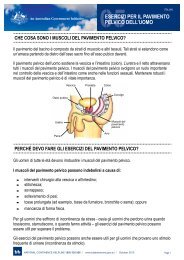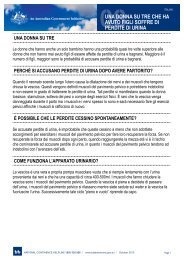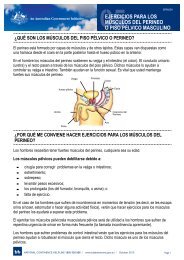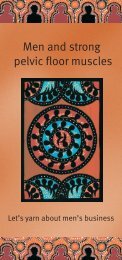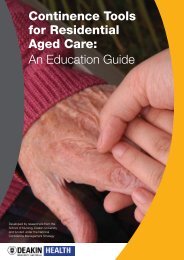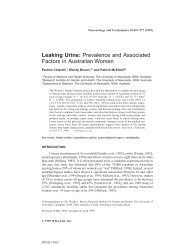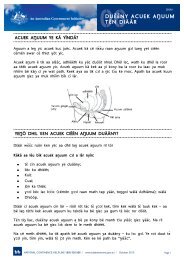Pharmacy Continence Care - Bladder and Bowel Website
Pharmacy Continence Care - Bladder and Bowel Website
Pharmacy Continence Care - Bladder and Bowel Website
You also want an ePaper? Increase the reach of your titles
YUMPU automatically turns print PDFs into web optimized ePapers that Google loves.
seek their qualitative feedback on the training implementation. The following is a summary<br />
of both those forms of feedback:<br />
• The trainers found this a high quality program overall.<br />
• The logistics of arranging individualised training for all pharmacies was time-consuming,<br />
with the most time-consuming aspect being setting it up. This included telephone <strong>and</strong><br />
self-paced training, which required an average of two phone calls to each pharmacy to<br />
set up the training arrangements (face-to-face training required three calls on average).<br />
The trainers suggested that having a training calendar that allowed pharmacies to sign<br />
up according to availability would overcome some of these “set up” issues.<br />
• The face-to-face session had significant drop-out rates, with participants not turning up<br />
<strong>and</strong> training sessions having to be rescheduled. This would be a very costly exercise<br />
indeed if it was magnified by 5000 (the number of pharmacies nationally).<br />
• Availability of samples of products was an initial issue. Both pharmacies <strong>and</strong> trainers<br />
expressed the need to have h<strong>and</strong>s-on examples of products which they could use to<br />
demonstrate application to specific client needs.<br />
• Some changes are needed to the materials (revising the anatomy diagram).<br />
• Training over the telephone was often difficult when trainees did not underst<strong>and</strong><br />
terminology. It was not always easy to explain without visual aids.<br />
• Production of a video of the training (provided by a qualified trainer) would be a costeffective<br />
way of assuring consistent quality of delivery to remote <strong>and</strong> all other locations.<br />
The <strong>Pharmacy</strong> Guild should consider production of such a resource. Given the availability<br />
of the materials, the high acceptance of the training session <strong>and</strong> the availability of<br />
trained trainers, this would be an economical way to address national roll-out.<br />
• Abena-Sanicare also expressed their desire to continue to be involved in the national rollout.<br />
The high level of satisfaction with the training expressed by pharmacies would<br />
support their claim.<br />
4.2.4 Results of the pilot Program from the pharmacy perspective<br />
In this element, the project team developed <strong>and</strong> implemented tools to measure the health<br />
<strong>and</strong> economic outcomes of the Program <strong>and</strong> evaluated the effectiveness <strong>and</strong> cost<br />
effectiveness of the intervention. This included advice by members of the NOVA Expert Panel<br />
on relevance <strong>and</strong> applicability of the recommendations of the National <strong>Continence</strong><br />
Management Strategy Outcomes Measurement Suite project to this project. The team also<br />
identified strategies for remuneration <strong>and</strong> sustainability for the service.<br />
4.2.5 Enhancing the community pharmacy role<br />
The community pharmacy role within the community<br />
In many respects, pharmacies <strong>and</strong> pharmacists play a role as members of primary health<br />
care teams. In this role it is important that they are informed about <strong>and</strong> link with other<br />
relevant primary care services <strong>and</strong> programs. To test what the pharmacies knew about<br />
available local resources <strong>and</strong> services, the NOVA team asked questions about the<br />
pharmacists’ knowledge of local services <strong>and</strong> the extent to which consumers were referred to<br />
pharmacists by other health care professionals, as well as referrals by pharmacists to other<br />
health care professionals <strong>and</strong> services.<br />
At the end of the pilot there were some significant improvements in knowledge about the<br />
range of other primary health care services that help people with continence problems,<br />
particularly knowledge of continence care nurse educators, physiotherapists, support groups,<br />
Final Report<br />
33<br />
NOVA Public Policy<br />
<strong>Pharmacy</strong> <strong>Continence</strong> <strong>Care</strong> Project



